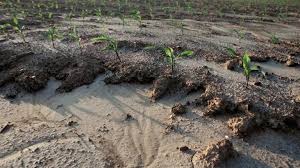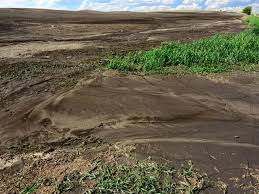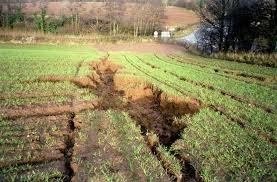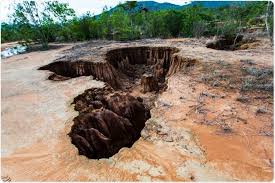In this article, the focus is on erosion, its physical processes, including water, gravitational, and wind erosion, as well as exfoliation. It also explains the factors influencing erosion rates and highlights human activities that contribute to increased erosion.
Additionally, the article addresses the global environmental consequences of erosion, and outlines effective prevention and remediation strategies.
Read Also: The Alfalfa Petals: Economic Importance, Uses, and By-Products
Meaning and Impact of Erosion in Agricultural Lands

Erosion is the process through which soil and rock are removed from the Earth’s surface by natural agents such as water and wind, then transported and deposited in new areas. Although erosion is a natural event, agricultural and other human activities have significantly increased its rate globally by 10 to 40 times. Excessive erosion leads to desertification, reduction in agricultural productivity due to topsoil loss, waterway sedimentation, and ecosystem collapse. Water and wind erosion together contribute to 84% of degraded land, making erosion a leading global environmental concern.
Major contributors include industrial farming, deforestation, road construction, urban expansion, and climate change. However, alternative practices like terrace construction, no-till farming, and revegetation can reduce erosion on farmlands.
Types of Water Erosion and Their Impact on Farmland
1. Rainfall Erosion: There are three main forms—sheet erosion (initial surface removal by rain), rill erosion (small channels form and carry sediments), and gully erosion (deep cuts formed by flowing water during heavy rain). These forms progressively degrade soil quality and remove fertile layers crucial for farming.
2. River and Stream Erosion: Continued water flow deepens valleys and widens riverbanks, especially during floods when erosion peaks. Particles transported by water further damage riverbeds and surrounding agricultural areas.
3. Bank and Thermal Erosion: Riverbanks gradually wear away, measured using metal rods. In frozen regions, thermal erosion caused by melting permafrost leads to rapid river channel shifts, which can drastically alter landscapes and farmland boundaries.
Coastal and Shoreline Erosion Impacting Coastal Agriculture
Waves and tidal movements cause shoreline erosion through processes such as hydraulic action, wave pounding, abrasion, corrosion, and bioerosion. These mechanisms wear down coastal farmland and can lead to the collapse of cliffs and arable lands. Sediment transport along shores results in the formation or loss of protective features like spits and sandbanks.
Glacial Erosion in Cold Agricultural Zones
Glaciers erode by abrasion, plucking, and ice thrusting, creating landforms such as drumlins and moraines. These processes reshape large areas of land, influencing soil availability and water flow patterns vital for agriculture in colder regions.
Flood Erosion and Its Sudden Impact
Massive floods form kolks or water vortices that carve out bedrock, creating landforms like Rock-cut basins. These can remove large areas of topsoil rapidly, affecting agricultural infrastructure and land productivity.
Freeze-Thaw Erosion in Upland Agriculture
Water trapped in rock cracks freezes and expands, breaking rock apart. The broken pieces (scree) accumulate on slopes, causing gravity erosion, which is a common hazard for farmlands located on or near mountain slopes.
Wind Erosion and Its Role in Land Degradation
Wind erosion is a serious issue in drylands, contributing to soil loss, dust storms, and reduced crop yields. It occurs mainly through deflation (soil particles lifted by wind) and abrasion (airborne particles erode surfaces). Deflation includes surface creep, saltation, and suspension, with saltation causing the most erosion.
Wind erosion intensifies in dry seasons and during droughts, with documented cases showing erosion rates thousands of times higher than during wet years. This severely affects crop performance and land sustainability.
Read Also : How to Plant Fruit Trees for Optimum Performance
Gravitational Erosion and Its Agricultural Implications

Mass movement, driven by gravity, includes processes such as landslides, slumping, and creep. These processes transport material downslope, often disrupting agricultural structures and fields. Slumping is common in clay-rich soils and may be worsened by poor road construction. Surface creep, although slow, gradually shifts topsoil and affects planting areas.
Exfoliation and Its Effect in Arid Farming Regions
Exfoliation occurs when intense heat causes rock expansion, followed by contraction during cooler temperatures, resulting in rock fragments breaking off. It is most common in desert farming zones and contributes to the breakdown of stony terrain, influencing land preparation and cultivation.
Key Factors Affecting Erosion Rates on Farmlands
1. Precipitation and Wind Speed: High-intensity rainfall and strong winds increase erosion. Larger and faster raindrops have greater energy, displacing more soil particles.
2. Soil Structure and Composition: Soils rich in clay or organic matter resist erosion better. Soil moisture and compaction also influence how much water is absorbed versus how much runs off.
3. Vegetative Cover: Vegetation protects soil from wind and rain. It enhances infiltration and binds soil particles. Removing vegetation exposes soil to erosion, particularly during heavy rains or windstorms.
4. Topography: Topography influences the speed of surface runoff, which affects its ability to cause erosion. Longer and steeper slopes, especially those without vegetation, are more likely to experience high erosion rates during heavy rains. These terrains are also more prone to mudslides and landslides, which are forms of gravitational erosion.
Human Activities that Increase Erosion Rates

1. Agricultural Practices
i. Unsustainable farming methods are the major cause of increased erosion globally. 1. Tillage of land breaks soil into finer particles, especially with modern machinery that allows deep plowing.
ii. Mono-cropping on slopes
iii. use of chemical fertilizers and pesticides
iv. surface irrigation also contribute. These practices remove soil-binding organisms and increase surface runoff. Additionally, wind erosion increases as tillage dries out the soil and trees are removed, allowing wind to blow freely. Heavy grazing also compacts the soil and removes protective vegetation.
2. Deforestation
Forests naturally protect the soil with leaf litter and humus, which absorb rainfall and reduce its impact. Tree roots bind the soil, and vegetation slows rainfall before it reaches the ground. When forests are cleared, this protection is lost. Logging and fire expose the soil, leading to compaction and increased erosion, especially after heavy rains. A severe example is Madagascar’s central plateau, where extensive slash-and-burn farming has made the land almost unproductive.
3. Roads and Urbanization
Urban development increases erosion by removing vegetation, changing drainage patterns, and compacting the soil. Concrete and asphalt surfaces increase runoff, carrying contaminated sediments into waterways. This disrupts watersheds and causes bank erosion along streams and rivers.
4. Climate Change
Climate change intensifies erosion through increased rainfall and extreme weather events. Rising sea levels also accelerate coastal erosion. Erosion rates rise due to changes in rainfall energy, vegetation cover, soil moisture, and temperature-related processes. Warmer winters bring more rain than snow, increasing erosion. Melting permafrost and land-use changes further worsen the situation. Research shows a 1.7% rise in erosion for every 1% increase in rainfall.
Global Environmental Effects
1. Land Degradation
Water and wind erosion cause most of the world’s land degradation. 1. About 75 billion tons of soil are lost yearly, which is 13 to 40 times faster than natural erosion rates. 2. Over 40% of global farmland is severely degraded. In Africa, continued soil loss may leave only 25% of the population with enough food by 2025.
2. Sedimentation of Aquatic Ecosystems
Eroded soil pollutes rivers and lakes, smothering fish spawning grounds, reducing food supplies, and damaging aquatic ecosystems. Sediments carry harmful chemicals, including pesticides and heavy metals. One of the worst examples is China’s Yellow River, which deposits over 1.6 billion tons of sediment into the ocean annually.
3. Airborne Dust Pollution
Wind erosion creates airborne dust, often containing toxic chemicals. This dust harms health and the environment, reduces rainfall, and changes sky color. African dust has been linked to coral reef decline in the Caribbean, while Gobi desert dust spreads across North America.
5. Tectonic Effects
Large-scale erosion removes heavy rock layers, which can lead to tectonic uplift in affected areas as the Earth’s crust adjusts to the reduced weight.
Monitoring, Measuring and Modeling Erosion
Understanding erosion involves using models and tools. The Universal Soil Loss Equation (USLE) is the most used formula for predicting water erosion:
A = RKLSCP
Where:
R = rainfall erosivity
K = soil erodibility
L and S = slope length and steepness
C and P = crop and land management factors
Tools like the Micro-Erosion Meter (MEM) and the Traversing MEM (TMEM) help monitor erosion in various environments, including rock and coastal systems.
Prevention and Remediation
1. Increasing vegetative cover is the most effective erosion prevention method, as it protects the soil from both wind and water erosion.
2. Terracing helps control runoff on slopes and has been used successfully for centuries.
3. Windbreaks (rows of trees or shrubs) reduce wind speed and protect crops.
4. Mixed cropping and crop rotation lower erosion by maintaining better soil structure and cover.
This article has explained erosion, its causes, global effects, and methods for measuring and preventing it. Due to the severe impact of erosion on land productivity and ecosystems, it is important to adopt effective preventive and restoration methods to protect the environment and ensure sustainable agriculture.
Do you have any questions, suggestions, or contributions? If so, please feel free to use the comment box below to share your thoughts. We also encourage you to kindly share this information with others who might benefit from it. Since we can’t reach everyone at once, we truly appreciate your help in spreading the word. Thank you so much for your support and for sharing!

